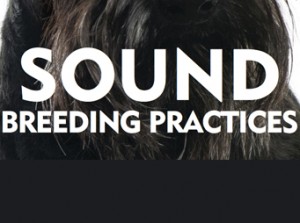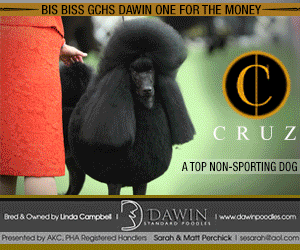Sound Breeding Practices
190 – August, 2016
BY WILLIAM GIVEN
 I am quite certain that there are many owners of highly successful stud dogs that are aghast at the quality of some of the bitches presented or sent to them for service. Too often the bitch is shipped in from a considerable distance, and considering the expense of shipping, to say nothing of the time and effort that shipping entails, one feels they simply cannot disappoint the owner, so the bitch is bred and returned. And, how can the owner of the stud dog not be preoccupied with the thought of “what those puppies will do to his or her dog’s reputation”.
I am quite certain that there are many owners of highly successful stud dogs that are aghast at the quality of some of the bitches presented or sent to them for service. Too often the bitch is shipped in from a considerable distance, and considering the expense of shipping, to say nothing of the time and effort that shipping entails, one feels they simply cannot disappoint the owner, so the bitch is bred and returned. And, how can the owner of the stud dog not be preoccupied with the thought of “what those puppies will do to his or her dog’s reputation”.
It is difficult for me to imagine the logic behind the thinking of a breeder that believes the attempt to breed a bitch that possesses a variety of major and minor faults, even to a top quality stud dog, will yield superior results. Too many breeders, and especially first time breeders, seem to believe that as long as the pedigree is full of dogs with a CH. in front of the names and that the stud dog is or was a top winning dog, the puppies will surely be great, and when this does not happen it must be the stud dog’s fault. If a breeder is trying to breed the ideal representative of the breed, it seems reasonable that said breeder should begin with selecting a bitch that has as few faults as possible.
In the end, it all boils down to the simple fact that only bitches of superior conformation, health and temperament should be used for breeding. Additionally, these brood bitches should have an outstanding pedigree behind them. If a bitch possesses all three of these elements, we can stack the odds for a quality litter in our favor while minimizing the mathematical probability of any major faults appearing in our puppies.
For example, we will suppose this multi-faulted bitch is bred to an outstanding, top-producing stud dog and (let us call him GCh. Mr. Magnificent) does whelp a very nice puppy (we will call him Mr. Marvelous) that at maturity builds for himself an enviable show record. Remembering he obtains half of his genes from his faulty dam which are obviously recessive or they would obviously have been on display, but nonetheless they are there in all of the puppies of the litter. When Ch. Mr. Marvelous enters the breeding program, at least half of the progeny will carry the genes for those faults. Now, this does not sound so bad until you consider that the original faulty bitch had numerous major and minor faults, and each fault has at least one pair of genes, and most of the qualities that we breed for are polygenetic, meaning they are the result of the interaction of numerous gene combinations. Then, multiply this by the number of faults and you have a large complex of genes that you would surely want to be breeding away from, not toward.
Perhaps only half of the offspring will carry genes for a faulty head, and only half will possess the genes for a weak topline; and only half the genes for a light eye, and only half the genes for cow-hocks, etc., on down the list of faults owned by the dam of Ch. Mr. Marvelous. This would all be of minor concern if all of the faults were present in the same half, but this is not the case. We must remember also that some factors are linked, some are not, but all may adversely affect the overall success of the progeny in the show ring and in a breeding program. This is a particularly dangerous situation when Ch. Mr. Marvelous is used at stud. He is, after all, carrying the genes for every single one of his dam’s major and minor faults
Click here to read the complete article190 – August, 2016
Short URL: http://caninechronicle.com/?p=110037
Comments are closed











